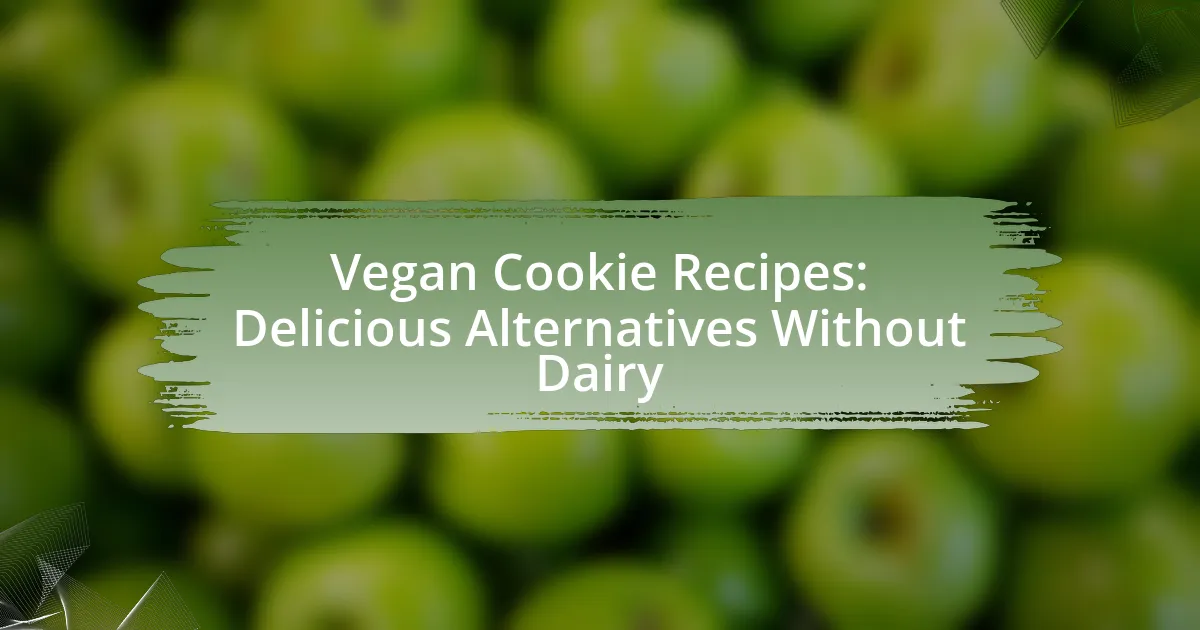The article focuses on the best chocolate combinations for gourmet cookies, highlighting pairings such as dark chocolate with sea salt, milk chocolate with caramel, and white chocolate with macadamia nuts. It explores how different types of chocolate enhance flavor profiles, the impact of cocoa content on taste, and the importance of pairing chocolate with complementary ingredients like nuts, fruits, and spices. Additionally, it discusses techniques for creating unique chocolate combinations, the role of texture in cookie enjoyment, and best practices for using chocolate in baking to achieve optimal flavor and quality.

What are the Best Chocolate Combinations for Gourmet Cookies?
The best chocolate combinations for gourmet cookies include dark chocolate with sea salt, milk chocolate with caramel, and white chocolate with macadamia nuts. Dark chocolate enhances the richness of cookies while sea salt adds a savory contrast, creating a balanced flavor profile. Milk chocolate paired with caramel provides a sweet and creamy texture, making it a popular choice for indulgent cookies. White chocolate combined with macadamia nuts offers a sweet and nutty flavor, appealing to those who enjoy a softer, sweeter cookie experience. These combinations are favored in gourmet baking for their ability to create complex and satisfying flavors.
How do different types of chocolate enhance gourmet cookies?
Different types of chocolate enhance gourmet cookies by contributing unique flavors, textures, and visual appeal. Dark chocolate adds a rich, intense flavor and a slight bitterness that balances sweetness, while milk chocolate offers creaminess and a smoother taste. White chocolate, although technically not chocolate, provides a sweet and buttery flavor that complements other ingredients. The varying cocoa content in these chocolates influences the overall taste profile, allowing for a more complex and satisfying cookie experience. For instance, a study published in the Journal of Food Science highlights that the combination of dark and milk chocolate can create a more balanced flavor, enhancing consumer preference for gourmet cookies.
What are the flavor profiles of dark, milk, and white chocolate?
Dark chocolate has a rich, intense flavor profile characterized by deep cocoa notes, bitterness, and a slight sweetness, often enhanced by fruity or nutty undertones. Milk chocolate features a creamier, sweeter taste due to the addition of milk solids, resulting in a smoother texture and flavors that include caramel and vanilla. White chocolate, while technically not chocolate as it lacks cocoa solids, offers a sweet and creamy flavor profile dominated by sugar and milk, with hints of vanilla. These distinct profiles influence their use in gourmet cookie recipes, where the balance of sweetness and richness can enhance the overall flavor experience.
How does the cocoa content affect the taste of gourmet cookies?
Cocoa content significantly influences the taste of gourmet cookies by determining their flavor intensity and richness. Higher cocoa content typically results in a more robust chocolate flavor, contributing to a deeper, more complex taste profile. For instance, cookies made with 70% cocoa chocolate exhibit pronounced bitterness and a rich, dark flavor, while those with lower cocoa percentages, such as 50%, tend to be sweeter and creamier. This variation in cocoa content also affects the texture; higher cocoa levels can lead to a denser cookie, while lower levels may produce a softer, more cake-like texture. Studies have shown that consumers often prefer cookies with higher cocoa content for their intense flavor and satisfying mouthfeel, reinforcing the importance of cocoa percentage in gourmet cookie recipes.
Why is pairing chocolate with other ingredients important?
Pairing chocolate with other ingredients is important because it enhances flavor complexity and balances sweetness. When chocolate is combined with ingredients like nuts, fruits, or spices, it creates a multi-dimensional taste experience that can elevate gourmet cookies. For example, the bitterness of dark chocolate complements the sweetness of caramel, while the creaminess of milk chocolate pairs well with the tartness of berries. This strategic pairing not only improves the overall flavor profile but also appeals to a wider range of palates, making the cookies more enjoyable.
What ingredients complement chocolate in gourmet cookies?
Vanilla, sea salt, nuts, and fruits complement chocolate in gourmet cookies. Vanilla enhances the overall flavor profile, while sea salt balances the sweetness and intensifies the chocolate taste. Nuts, such as walnuts or pecans, add texture and richness, and fruits like cherries or orange zest provide a contrasting freshness that elevates the cookie experience. These combinations are widely recognized in gourmet baking, as they create a harmonious blend of flavors and textures that appeal to a broad range of palates.
How do spices and extracts influence chocolate flavor in cookies?
Spices and extracts significantly enhance chocolate flavor in cookies by adding complexity and depth. For instance, cinnamon can introduce warmth and sweetness, while vanilla extract amplifies the chocolate’s richness. Research indicates that spices like nutmeg and cardamom can create a harmonious balance, elevating the overall taste profile. Additionally, extracts such as almond or orange can provide contrasting notes that complement the chocolate, making the flavor more intriguing. These enhancements are supported by sensory analysis studies, which show that the combination of spices and extracts can lead to a more enjoyable and multifaceted chocolate experience in baked goods.
What are some popular chocolate combinations for gourmet cookies?
Popular chocolate combinations for gourmet cookies include dark chocolate with sea salt, milk chocolate with caramel, and white chocolate with macadamia nuts. Dark chocolate paired with sea salt enhances the rich flavor profile, creating a balance between sweetness and saltiness. Milk chocolate combined with caramel offers a creamy texture and a delightful sweetness, making it a favorite among cookie enthusiasts. White chocolate mixed with macadamia nuts provides a rich, buttery flavor that complements the sweetness of the chocolate, resulting in a luxurious cookie experience. These combinations are widely recognized for their ability to elevate the taste and appeal of gourmet cookies.
Which nuts pair best with chocolate in cookie recipes?
Almonds, walnuts, and pecans pair best with chocolate in cookie recipes. Almonds provide a crunchy texture and a slightly sweet flavor that complements chocolate well. Walnuts add a rich, earthy taste and a satisfying crunch, enhancing the overall flavor profile. Pecans offer a buttery richness that balances the sweetness of chocolate, making them a popular choice in gourmet cookies. These nuts not only enhance the taste but also contribute to the texture, making cookies more enjoyable.
How do fruits and chocolate work together in gourmet cookies?
Fruits and chocolate complement each other in gourmet cookies by balancing sweetness and acidity, enhancing flavor complexity. The natural sugars in fruits, such as berries or citrus, provide a tart contrast to the rich, creamy texture of chocolate, creating a harmonious taste experience. For example, dark chocolate pairs well with tart cherries, as the bitterness of the chocolate offsets the fruit’s acidity, resulting in a well-rounded flavor profile. Additionally, the moisture content in fruits can contribute to a softer cookie texture, making the final product more enjoyable. This combination is supported by culinary practices that emphasize the use of contrasting flavors to elevate desserts, demonstrating that the interplay between fruits and chocolate is a key element in gourmet cookie recipes.

How can you create unique chocolate combinations for cookies?
To create unique chocolate combinations for cookies, experiment with various types of chocolate and complementary flavors. For instance, combining dark chocolate with sea salt enhances the richness, while pairing milk chocolate with orange zest adds a citrusy brightness. Additionally, incorporating ingredients like nuts, spices, or dried fruits can further diversify the flavor profile. Research indicates that flavor pairing can significantly enhance taste experiences, as seen in culinary studies that explore the science of complementary flavors.
What techniques can be used to experiment with chocolate pairings?
To experiment with chocolate pairings, one effective technique is to conduct a flavor profile analysis, where different chocolate types are matched with complementary or contrasting ingredients. This can include pairing dark chocolate with sea salt or citrus fruits, while milk chocolate may be paired with caramel or nuts. Another technique involves blind taste tests, allowing participants to evaluate various combinations without bias, which can reveal unexpected preferences. Additionally, utilizing a systematic approach, such as the flavor wheel, can help identify potential pairings based on shared flavor compounds. These methods are supported by culinary studies that emphasize the importance of balancing sweetness, bitterness, and acidity in flavor combinations, enhancing the overall tasting experience.
How can you balance sweetness and bitterness in chocolate combinations?
To balance sweetness and bitterness in chocolate combinations, use a blend of dark chocolate and milk chocolate. Dark chocolate, with its higher cocoa content, provides bitterness, while milk chocolate adds sweetness. This combination allows for a harmonious flavor profile that enhances the overall taste experience. Research indicates that a 70% dark chocolate paired with a 30% milk chocolate creates a balanced flavor, appealing to a wide range of palates.
What role does texture play in chocolate and cookie pairings?
Texture significantly influences the enjoyment and overall experience of chocolate and cookie pairings. The contrast between the smooth, creamy texture of chocolate and the crunchy or chewy texture of cookies creates a harmonious balance that enhances flavor perception. For instance, a crisp cookie paired with a rich, velvety chocolate can provide a satisfying mouthfeel, while a soft cookie with a melt-in-your-mouth chocolate offers a different sensory experience. Research indicates that texture affects taste perception, with studies showing that people often associate certain textures with specific flavors, thereby enhancing the overall enjoyment of the pairing.
Why should you consider seasonal ingredients in chocolate combinations?
Considering seasonal ingredients in chocolate combinations enhances flavor, freshness, and sustainability. Seasonal ingredients are often at their peak in taste and nutritional value, which can elevate the overall quality of chocolate products. For example, using fresh berries in summer or pumpkin in fall can create unique flavor profiles that resonate with consumers’ preferences during those times. Additionally, sourcing seasonal ingredients supports local agriculture and reduces the carbon footprint associated with transporting out-of-season produce. This practice not only aligns with consumer trends favoring sustainability but also fosters a connection between the product and the season, making the chocolate experience more memorable.
What seasonal flavors can enhance chocolate in gourmet cookies?
Seasonal flavors that can enhance chocolate in gourmet cookies include peppermint, pumpkin spice, and cinnamon. Peppermint, often associated with winter holidays, adds a refreshing contrast to rich chocolate, making it popular in festive treats. Pumpkin spice, a fall favorite, combines cinnamon, nutmeg, and clove, creating a warm, comforting flavor profile that complements chocolate well. Cinnamon, versatile across seasons, enhances chocolate’s depth with its warm, sweet-spicy notes, making it a staple in various cookie recipes. These flavors not only elevate the chocolate experience but also align with seasonal culinary trends, appealing to consumer preferences during specific times of the year.
How can local ingredients influence chocolate pairings?
Local ingredients can significantly enhance chocolate pairings by introducing unique flavors and textures that complement the chocolate’s profile. For instance, using locally sourced fruits, nuts, or spices can create harmonious combinations that reflect regional tastes and traditions. Research indicates that flavor compounds in local ingredients can interact with chocolate’s cocoa notes, resulting in a more complex and enjoyable tasting experience. For example, pairing chocolate with locally grown berries can enhance the chocolate’s sweetness while adding acidity, creating a balanced flavor profile.

What are the best practices for using chocolate in gourmet cookies?
The best practices for using chocolate in gourmet cookies include selecting high-quality chocolate, properly tempering it, and balancing flavors. High-quality chocolate, such as couverture chocolate, enhances the overall taste and texture of the cookies. Proper tempering ensures a glossy finish and a satisfying snap, which is crucial for visual appeal and mouthfeel. Balancing flavors involves pairing chocolate with complementary ingredients like nuts, spices, or fruits to create a harmonious taste profile. These practices are supported by culinary experts who emphasize the importance of ingredient quality and technique in gourmet baking.
How should chocolate be prepared for cookie recipes?
Chocolate should be prepared for cookie recipes by chopping it into uniform pieces or melting it, depending on the recipe requirements. Chopping chocolate into small, even pieces ensures consistent melting and incorporation into the cookie dough, while melting chocolate allows for a smoother texture and richer flavor in the final product. For instance, when using semi-sweet chocolate, it is often recommended to chop it into small chunks to create gooey pockets of chocolate in the cookies. Melting chocolate can be done using a double boiler or microwave, ensuring it is heated gently to avoid burning. This preparation method enhances the overall taste and texture of gourmet cookies, making them more enjoyable.
What are the best melting techniques for different types of chocolate?
The best melting techniques for different types of chocolate include the double boiler method for dark chocolate, microwave melting for milk chocolate, and tempered melting for white chocolate. The double boiler method involves placing a heatproof bowl over simmering water, allowing dark chocolate to melt gently without burning, which is crucial since it has a higher cocoa content and can scorch easily. Microwave melting, on the other hand, is effective for milk chocolate; it requires short bursts of heat, typically 20-30 seconds, stirring in between to prevent overheating, as milk chocolate contains milk solids that can burn. For white chocolate, which is more sensitive to heat, tempered melting is recommended; this involves melting the chocolate to a specific temperature and then cooling it down to stabilize the cocoa butter, ensuring a smooth and glossy finish. These techniques are validated by culinary experts who emphasize the importance of temperature control in achieving the desired texture and flavor in chocolate.
How can you prevent chocolate from seizing during baking?
To prevent chocolate from seizing during baking, ensure that no moisture comes into contact with the chocolate. Moisture causes the sugar in chocolate to clump, leading to a grainy texture. Use dry utensils and bowls, and avoid steam when melting chocolate. Additionally, melt chocolate slowly over low heat or in a microwave in short intervals, stirring frequently to maintain a smooth consistency. This method is supported by culinary practices that emphasize the importance of controlling temperature and moisture to achieve optimal chocolate texture.
What tips can improve the overall quality of chocolate cookies?
To improve the overall quality of chocolate cookies, use high-quality chocolate and adjust the baking time for optimal texture. High-quality chocolate, such as couverture or artisan brands, enhances flavor and richness, while precise baking time ensures cookies remain chewy and not overbaked. Research indicates that using chocolate with a higher cocoa content can elevate the taste profile significantly, as noted in culinary studies. Additionally, chilling the dough before baking can improve the cookie’s structure and flavor development, leading to a more satisfying final product.
How can you ensure even distribution of chocolate in cookie dough?
To ensure even distribution of chocolate in cookie dough, incorporate the chocolate chips or chunks into the dry ingredients before adding the wet ingredients. This method allows the chocolate to be evenly coated with flour, preventing clumping and promoting uniform distribution throughout the dough. Studies in baking science indicate that mixing dry ingredients first helps achieve a consistent texture and flavor in baked goods, as it allows for better integration of all components.
What common mistakes should be avoided when using chocolate in cookies?
Common mistakes to avoid when using chocolate in cookies include using chocolate that is not high-quality, which can lead to a lack of flavor and poor texture. Additionally, not properly measuring the chocolate can result in an imbalance of ingredients, affecting the overall taste and consistency of the cookies. Overheating chocolate during melting can cause it to seize, making it unusable in the cookie dough. Lastly, neglecting to consider the type of chocolate—such as dark, milk, or white—can lead to unexpected flavor profiles that may not complement the other ingredients. These mistakes can significantly impact the quality of the final product.




